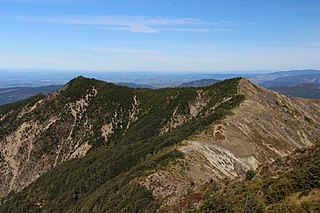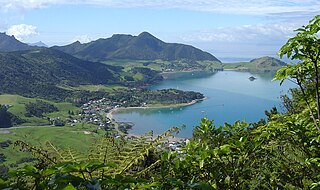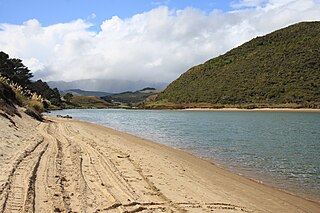Related Research Articles

The North Island, also officially named Te Ika-a-Māui, is one of the two main islands of New Zealand, separated from the larger but less populous South Island by Cook Strait. With an area of 113,729 km2 (43,911 sq mi), it is the world's 14th-largest island, constituting 44% of New Zealand's land area. It has a population of 3,997,300, which is 77% of New Zealand's residents, making it the most populous island in Polynesia and the 28th-most-populous island in the world.

Kaipara District is a territorial authority district in the Northland Region of New Zealand.

Waipoua Forest is a forest, on the west coast of the Northland Region of New Zealand's North Island. It preserves some of the best examples of kauri forest remaining in New Zealand. It is notable for having two of the largest living kauri trees, Tāne Mahuta and Te Matua Ngahere.

Tāne Mahuta, also called "God of the Forest", is a giant kauri tree in the Waipoua Forest of Northland Region, New Zealand. Its age is unknown but is estimated to be between 1,250 and 2,500 years. It is the largest living kauri tree known to stand today. It is named for Tāne, the Māori god of forests and of birds.

Te Matua Ngahere is a giant kauri coniferous tree in the Waipoua Forest of Northland Region, New Zealand. The tree's Māori name means "Father of the Forest". Although not as massive or tall as its neighbour Tāne Mahuta, Te Matua Ngahere is stouter, with a girth just over 16 metres (52 ft). It is believed to be the second largest living kauri tree, and to have the biggest girth of any kauri in the country. According to The New Zealand Herald, it has the biggest girth of any tree in New Zealand.

The environmental movement in New Zealand started in the 1950s, a period of rapid social change. Since then numerous high-profile national campaigns have contested various environmental issues. The environmental movement eventually spawned the Values Party, which was the first political party with a strong focus on environmental issues to contest national elections. The Values Party eventually morphed into the Green Party of Aotearoa New Zealand.

Conservation park is a type of specially protected status for land held by the Crown in New Zealand for conservation purposes. The status is set up under the Conservation Act 1987 and the parks are administered by the Department of Conservation (DoC).

Opononi is a settlement on the south shore of Hokianga Harbour in Northland, New Zealand. State Highway 12 runs through Opononi. Ōmāpere is on the shore to the south of Opononi and Pakanae to the northeast.

Whangarei District is a territorial authority district in the Northland Region of New Zealand that is governed by the Whangarei District Council. The district is made up in area largely by rural land, and includes a fifth of the Northland Region. It extends southwards to the southern end of Bream Bay, northwards to Whangaruru and almost to the Bay of Islands, and westwards up the Mangakahia River valley past Pakotai and almost to Waipoua Forest. It includes the Hen and Chicken Islands and the Poor Knights Islands.

Te Roroa is a Māori iwi from the region between the Kaipara Harbour and the Hokianga Harbour in Northland, New Zealand. They are part of the Ngāti Whātua confederation of tribes.
The Kaihu River is a river of the far north of New Zealand's North Island. It flows southeast from just south of Waipoua Forest, reaching the Wairoa River at the town of Dargaville.

The Waimamaku River is a river in the Northland Region of New Zealand's North Island. It has a catchment of 133 square kilometres. Its name is Māori for "water of mamaku fern".
Waipoua River is the name of two rivers in New Zealand.
The Waipoua River is a river of the Northland Region of New Zealand's North Island. It flows generally west from its sources in the Parataiko Range to reach the Tasman Sea 15 kilometres southeast of the mouth of the Hokianga Harbour. Much of the river's length is through the Waipoua Kauri Forest.

State Highway 12 is a New Zealand state highway in the far north of the North Island. It connects with SH 1 at both its northern and southern end. It runs close to the west coast of the Northland Region of New Zealand.
Waipoua is a genus of Polynesian araneomorph spiders in the family Orsolobidae, and was first described by Raymond Robert Forster & Norman I. Platnick in 1985.

Waipoua Settlement is a rural community in the Kaipara District of Northland, in New Zealand's North Island.
Northland Conservation Park is a group of protected areas in the Northland Region of New Zealand's North Island.

The Twin Coast Discovery Highway is an 800-kilometre (500 mi) circular road route of Northland, a region located in New Zealand. Most of the route travels on part of State Highway 1 (SH 1), the longest and major road in New Zealand, but some parts spur off onto other roads. It is commonly used as a tourist route, most of the time to visit Cape Reinga. The name "Twin Coast Discovery" is so named because the route up to and back from Cape Reinga are on different coasts.

A sanctuary area is a type of New Zealand protected area. They exist to preserve populations of important forest types, like the remnants of kauri forests in Northland.
References
- ↑ "Place name detail: Waipoua River". New Zealand Gazetteer. New Zealand Geographic Board . Retrieved 18 March 2018.